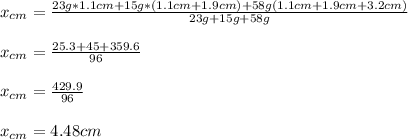
Physics, 06.04.2020 16:30 Damagingawsomeness2
Three beads are placed along a thin rod. The first bead, of mass m1 = 23 g, is placed a distance d1 = 1.1 cm from the left end of the rod. The second bead, of mass m2 = 15 g, is placed a distance d2 = 1.9 cm to the right of the first bead. The third bead, of mass m3 = 58 g, is placed a distance d3 = 3.2 cm to the right of the second bead. Assume an x-axis that points to the right.
a. Write a symbolic equation for the location of the center of mass of the three beads relative to the left end of the rod, in terms of the variables given in the problem statement.
b. Find the center of mass, in centimeters, relative to the left end of the rod.
c. Write a symbolic equation for the location of the center of mass of the three beads relative to the center of bead, in terms of the variables given in the problem statement.
d. Find the center of mass, in centimeters, relative to the middle bead.

Answers: 1


Other questions on the subject: Physics


Physics, 23.06.2019 00:50, Madisonaubrey22
A980-kg sports car collides into the rear end of a 2300-kg suv stopped at a red light. the bumpers lock, the brakes are locked, and the two cars skid forward 2.6m before stopping. the police officer, estimating the coefficient of kinetic friction between tires and road to be 0.80, calculates the speed of the sports car at impact. what was that speed?
Answers: 3

Physics, 23.06.2019 01:00, exoticbunnylover123
Learning goal: to understand newton's 1st law. newton's principia states this first law of motion: an object subject to no net force maintains its state of motion, either at rest or at constant speed in a right line. this law may be restated as follows: if the sum of all forces acting on an object is zero, then the acceleration of that object is zero. mathematically this is just a special case of the 2nd law of motion, f⃗ =ma⃗ , when f⃗ =0. when studying newtonian mechanics, it is best to remember the 1st law in two ways: if the net force (i. e., sum of all forces) acting on an object is zero, the object will keep moving with constant velocity (which may be zero). if an object is moving with constant velocity, that is, with zero acceleration, then the net force acting on that object must be zero. complete the following sentences to see if you can apply these ideas. part a if a car is moving to the left with constant velocity, one can conclude that
Answers: 1

Physics, 23.06.2019 01:00, shubbs1038a
First answer marked as brainiest which is the correct equation describing the first law of thermodynamics? a) when the internal energy of a system changes, it equals the amount of heat added plus the work done. b) when work is done by the piston, it is equal to the heat added plus the change in internal energy of the system. c) when heat is added to the system, it is equal to the amount of work done by the piston plus the change in internal energy of the system.
Answers: 2
You know the right answer?
Three beads are placed along a thin rod. The first bead, of mass m1 = 23 g, is placed a distance d1...
Questions in other subjects:


Mathematics, 16.12.2020 18:30


Spanish, 16.12.2020 18:30

Computers and Technology, 16.12.2020 18:30



Mathematics, 16.12.2020 18:30

Mathematics, 16.12.2020 18:30











